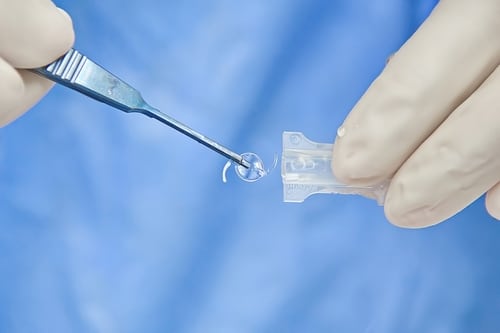Cataracts can impact many aspects of your life. This can include your ability to qualify for the most common permanent vision correction option: LASIK.
Fortunately, LASIK is not the only way to achieve greater visual freedom. Refractive Lens Exchange (RLE) can also deliver crystal clear vision without the need for glasses.
However, you may be wondering if you can still get RLE if you have cataracts or other options that might be able to help you reduce your need for visual aids. Keep reading to find out if you can get Refractive Lens Exchange if you have cataracts!
What Is Refractive Lens Exchange?
RLE is a type of eye surgery that can permanently correct refractive errors. A refractive error is a vision problem that leads to blurry vision.

During the RLE procedure, the eye’s lens is replaced with an intraocular lens or IOL. This lens contains the focusing power you need to see clearly, effectively reducing your need for glasses or contacts.
RLE differs from other corrective surgeries, such as LASIK, which alters the actual shape of the cornea. For this reason, RLE is a good option for those who are unable or prefer not to undergo LASIK.
One significant advantage of RLE is that you won’t have to deal with cataracts later in life. A cataract cannot grow on the synthetic surface of an intraocular lens.
RLE is an outpatient procedure. You will not have to go to a hospital or stay in one to recover. The recovery period is short, and most patients begin to notice improvements in their vision within a day.
What’s the Difference Between RLE and Cataract Surgery?
RLE is very similar to cataract surgery. In fact, they both follow the same general process: the eye surgeon replaces your natural lens with an artificial one.
The only difference is that people who undergo cataract surgery already have a cataract. Both cataracts and refractive errors have to do with your eye’s lens.
Cataracts
A cataract is a clouding of your eye’s lens. They are very common and typically occur due to aging, often beginning to form when a person is in their forties.
Cataracts progress slowly, but they can make your vision increasingly blurry or foggy. They can also make images appear duller.
With cataract surgery, when the natural lens is removed, so is the cataract. What many people do not realize is that, despite its name, cataract surgery can do more than remove a cataract.
Like RLE, it can also offer permanent vision correction.
IOL Choice
Both RLE and cataract surgery involve intraocular lenses, which can correct a refractive error. Depending on the type of lens you choose, cataract surgery can allow you to see clearly without the need for glasses or contacts.

If you choose a standard IOL with your cataract surgery, you will likely still have to rely on glasses or contacts to see clearly. A standard, or monofocal, lens can only provide clear vision at a single distance, whether near, intermediate, or far.
Patients with these lenses will still need visual aids for other distances. If you decide to correct your vision with a premium lens, you can reduce your need for visual aids after surgery.
With a multifocal or accommodating lens, your eye will be able to focus at multiple distances, without having to rely on visuals aids as much or at all. So, by choosing a premium IOL, cataract surgery can deliver near identical results to RLE.
Which Procedure Is Better for Cataract Patients?
If you have a cataract, the procedure is considered cataract surgery. The determination of whether it’s RLE or cataract surgery typically comes down to how far the cataract has progressed.
Generally, RLE is recommended if a refractive error is your primary concern. Cataract surgery is recommended if the symptoms of a cataract, such as blurry vision, poor night vision, and faded colors, are your primary concern.

If your cataract is still in the early stages, RLE can be an excellent option for vision correction. Because your natural lens will be removed during the procedure, your cataract will not advance any further.
Some people also choose RLE over another corrective procedure like LASIK so they never have to worry about developing a cataract.
Most of the time, cataracts are advanced enough to warrant cataract surgery. If a cataract is affecting your daily quality of life, then it’s time to consider cataract surgery.
Cataract surgery is designed to eliminate cataracts, and by choosing a premium IOL, you can achieve the clear vision you are looking for.
Are you looking for a way to remove your cataract and correct your vision? Our doctors are ready to help determine your best route to vision satisfaction. Schedule an appointment at Jacksonville Eye Center in Jacksonville, FL, today!
